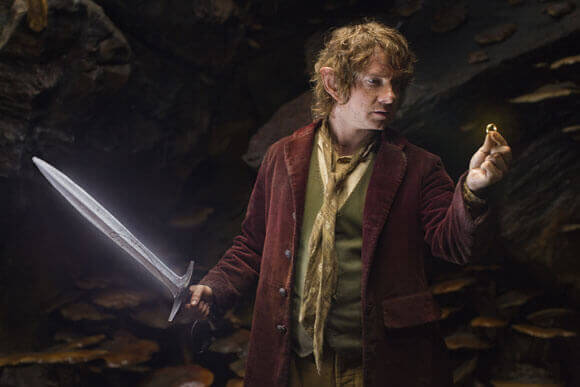
Peter Jackson struck nerd gold with the Lord of the Rings trilogy. Using a combination of good actors, state-of-the-art CGI, top-notch make-up, finely crafted costumes, and the New Zealand landscape, he managed to turn a beloved series of books into films that not only remained faithful to the source material but appealed to more than just the hardcore fan base; eventually earning himself some Oscar hardware with The Lord of the Rings: The Return of the King. Now, after a failed attempt to put Guillermo del Toro in the director’s chair, Jackson is back with another trilogy based on the work of J.R.R. Tolkien, only this time it’s based on just one book, The Hobbit: An Unexpected Journey.
There’s a fundamental difference between making three movies based on three books and making three movies based on one book; there simply isn’t enough material to make it necessary. While diehard fans may appreciate seeing as much of the book translated to the big screen, the simple truth is that there is a lot of this first movie that could have been left on the cutting room floor or on the extended cut included on the Blu-ray (I don’t even want to know what actually was cut after seeing all that was included).
Instead of an opening act that provided exposition and laid the groundwork, this is an opening movie. While there are a few fight scenes, what information is provided in this movie could have been done with a good hour trimmed out via some thoughtful screenwriting and editing. Also, spoiler alert, there’s a lot of walking. Weird, right? (Smell that sarcasm.)
From an acting perspective there is a bit of a disconnect between Martin Freeman’s Bilbo Baggins and the rest of the cast. While you won’t find many who are more fond of Freeman than me, his approach to the character isn’t all that different from his approach to the normal Londoner. Everyone else seems to have bought into the notion that they live in Middle Earth, he’s about to go shopping at Harrods.
The script also fails in trying too hard to cram levity into the mix in order to create distinct characterizations for each of the 13 dwarves. At times, it seems like they confused this with the tale of Snow White because there’s almost a silliness to some of their behavior and it’s very much at odds with the grittier tone of the Lord of the Rings, which is what helped people take Tolkien’s fantasy world seriously.
Speaking of script issues, perhaps the smartest thing Jackson and company did with the Lord of the Rings was eliminate the character of Tom Bombadil. If you don’t know who that is, just trust me when I say that trying to bring him to screen would have seemed ludicrous and broken the atmosphere of the film, so it was good he got the axe. Here, Jackson would have been better off removing Radagast the Brown, a wizard that crosses paths with Gandalf, Bilbo, and the dwarves. It would have been easy enough to make up for whatever exposition he provided, and the scenes of him being pulled by bunnies on a sled through the forest are so ridiculous that I almost cringed.
Speaking of problems with Radagast on a sled, this brings me to the 48 frames per second debate, also called HFR (high frame rate). The Hobbit: An Unexpected Journey will be the industry guinea pig although many expect this to be a thing of the future – much like 3D probably being here to stay. What HFR means is that rather than presenting a film at the normal 24 frames per second audiences are accustomed to, Jackson is doubling the frame rate which is supposed to provide a smoother look and eliminate the motion blur that often happens with fast action, especially if it’s in 3D.
The end result is a bit hard to judge. I was able to see the HFR 3D presentation, and it took me 10 to 15 minutes to get acclimated to what at first seemed like characters moving a bit too quickly; almost as if the film was slightly fast-forwarded. After that, there were some truly beautiful scenes that resemble the ultra-realistic presentation you see on newer HDTVs, though some see it as a soap opera-like effect and it’s ultimately up to the viewer to decide if they like it that way.
However, there were also a number of scenes, largely with Radagast on a sled (what a callback!) that broke my suspension of disbelief. Watching him zipping around, as well as a few other fast-motion scenes, created a cartoony look that detracted from the Middle Earth aesthetic which works best when it’s gritty and rooted in physicality. Succumbing to CGI effects that look entirely like CGI effects is the exact opposite of what I want out of this set of films.
Now, for anyone out there who doesn’t want to bother with this new-fangled technology, The Hobbit will be shown in pretty much every format possible: 24 fps in 2D and 3D, 48fps (HFR) in 2D and 3D (sorry, no smell-o-vision). Just pay attention when buying your tickets, so you get the experience you want. I personally enjoyed seeing the HFR 3D version because while the movie itself is decent enough, the real draw for me is seeing what many in the industry are saying will be the future of cinema (though it would be better if there were only 2 movies so the story could be tightened up).
In the end, I don’t really think I need to say whether or not you should see The Hobbit: An Unexpected Journey. There are legions of fans who will turn out in droves, though it will be interesting to see if this has the wider appeal the Lord of the Rings trilogy enjoyed as many may see this as simply going back to the well and not providing much they haven’t seen before. This isn’t as good as any of the trilogy we’ve already seen translated from Tolkien’s works but as a fan of the books and fantasy films in general, it was a fun experience (though make sure to use the restroom before it starts because of the 2 hour, 49-minute runtime).
Looking ahead, I’m mostly looking forward to seeing how Jackson handles the bigger spectacle scenes involving Smaug the Dragon and the Battle of Five Armies. For all of the problems inherent in stretching a story simply to make a neat little package of Blu-rays, Jackson does know how to do big, epic battles. That will be enough to get me through the next two films, but then again, as a film critic, I don’t pay for these things. You’ll need to weigh the balance of expense versus entertainment value for yourself.
GRADE: C+
The Hobbit: An Unexpected Journey opens in theaters on December 14, 2012 and is rated PG-13 for extended sequences of intense fantasy action violence, and frightening images.





